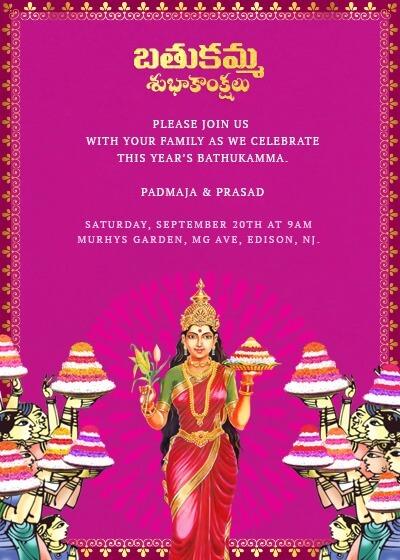
The festival of Bathukamma is celebrated by the profusion of flowers being arranged in beautiful pagoda-like structures to welcome the abundance of the Mother Goddess, known as Goddess Maha Gauri or Gauri Devi. Though considered to be predominantly a celebration in Telangana, parts of the states of Andhra Pradesh and Maharashtra, the Vidharbha region in particular also see communities honouring this traditional festival. These celebrations are spread out over nine days, beginning with Engili pula Bathukamma and ending with Sadhula Bathukamma, or Pedda Bathukamma. These celebrations almost coincide with other festivals being celebrated in other parts of India, such as Durgashtami which marks the last day of celebrations, with Bathukamma ending two days before the Dussehra celebrations in North India. At Inytes.com, we are most pleased to offer you our fine selection of Bathukamma Inytes for you to share with your family and friends as you welcome them to your home to celebrate on one or all of the days of this most auspicious festival in honor of the Divine Goddess.
Celebrating Womanhood and Role of Women
Bathukamma is focused on the women of the household, with the men being the ones who would traditionally bring flowers to the women in their homes, mothers, wives and daughters, so that they could be arranged into the “gopura” arrangements. This style of flower arrangement is said to be inspired by the holy gopura of the temple and is recreated as a seven-tiered wooden pyramid that allows for the flowers to be arranged in a visually superior fashion. During the celebrations that honour the Goddess Parvati and the gifts that she has bestowed upon the family, the younger women of the household wear half-sarees or lehenga cholis and a fair amount of jewelry to look their best.
The Many Days of Bathukamma
There are nine days of Bathukamma celebrations with each day having a specific food associated with it, prepared as an offering to the Goddess Gauri Devi. This offering is known as a “Naivedyam”. The first day of Bathukamma is called “Engili pula Bathukamma” and on this day the food offered is a preparation of sesame seeds and a coarsely ground rice batter, known as “nookalu”, or rice flour. On the second day, “Atkula Bathukamma”, the naivedyam is a preparation of boiled lentils, jaggery or unrefined, brown sugar, and flattened half-cooked rice which is known as “atkula”. “Muddapappu Bathukamma” is the third day of the celebration and features an offering prepared from soft boiled lentils known as “muddapappu”, along with jaggery and milk. The fourth day of Bathukamma is known as “Nanabiyyam Bathukamma” and is a day when jaggery, milk and soaked rice, the last of these which is known as “nananesina biyyam” are prepared together as that day’s naivedyam. Then, moving on to the fifth day of celebrations, “Atla Bathukamma”, a crepe-like dish called “uppidi pindi atlu” is prepared from wheat as the food offered to the goddess on this day.
All of this food preparation is given a day’s break on the sixth day, or “Aligina Bathukamma”, where no naivedyam is offered. “Vepakayala Bathukamma” is the seventh day of Bathukamma, but this time in spite of the name signifying the neem tree, it is only rice flour that is used to prepare a dish that merely resembles the fruit of this revered tree. This brings us to the penultimate day of Bathukamma, “Vennamuddala Bathukamma”, and the naivedyam prepared on this day involves clarified butter or simply butter, known as “venna”, along with sesame seeds and jaggery. On the last and final day, known either as Sadhula Bathukamma or Pedda Bathukamma, five different rice dishes as prepared as offerings, which are sesame rice (“nuvvula saddi”), curd rice (“perugannam saddi”), coconut rice (“kobbara saddi”), tamarind rice (“chinthapandu puliohara saddi”) and lemon rice (“nimmakaya saddi”).
For those of you who may be interested in learning more about the festival of Bathukamma, the State Government of Telangana has a website dedicated to information about this festival – https://bathukamma.telangana.gov.in
Once you have learned about Bathukamma to your heart’s content, then do be sure to check out the Bathukamma Inytes we have on offer. You can use them to help bring your loved ones together for the celebrations, as well as to help you plan the celebrations themselves, thanks to being able to track the RSVPs to help you organize around specific numbers of Inytees. On that note, the team at Inytes.com would like to wish you all a joyous observance of Bathukamma, and many days of celebrations in honor of Goddess Maha Gauri.
As the centrepiece of the Bathukamma festival, the flower arrangement, or “Bathukamma” is carefully prepared by the women of the household. It is an elaborately layered assortment of flowers that are seasonally abundant and can include the more ornate Celosia or cockscomb blooms, as well as the more down-to-earth and rather common Tridax procumbens, a humble member of the daisy family. On this note, we thought we would provide you with a little guide on how to go about preparing this flower pyramid, or pagoda, or “gopura”, if you will, no matter where in the world you may be celebrating Bathukamma. Once you have gone through our easy-to-follow instructions, we the team at Inytes.com would be thrilled if you would share the Bathukamma flower arrangement that you have created with the beautiful flowers that you have managed to source from your local markets. Depending on the kind of response we receive, we may even declare a few of these submissions as “Honorable Mentions”.
How To Prepare a Bathukamma
To begin with you will need the following items to help set the structure in more firmly:
- A Large Round Plate or circular surface that will form the platform on which you can begin to build up the layers of this arrangement. A large steel or metal plate will suffice, but if you happen to have a large sturdy plastic disc of any kind then this will work too.
- A Large Paper Plate that is solid in its manufacture and will not bend or buckle under the weight of whatever is placed on top of it. Please note, this paper plate should be smaller than the large round plate or circular base that it will sit on, maybe even as large, but certainly not larger. Traditionally, these plates, or “Vistharaku” are made from large leaves that have been pressed together and dried, so they are firm but will also breakdown once they are immersed in a body of water as they are ritually disposed of at the end of the festival.
- A large length of sturdy string or twine, which will be used to help secure the flower arrangement for potential transportation and eventual ritual disposal. Please note, the rules regarding the disposal of these flowers may vary depending on where in the world you are, so please follow the rules and dispose of your Bathukamma arrangement accordingly.
- Wooden skewers, an optional inclusion in this list, to allow you to compensate for flowers that do not have a long stem in order to arrange them more securely so that they do not shift around as other flowers are arranged above them.
- Bamboo or Plywood splints, another optional inclusion which honestly are only necessary if you plan to make a very large Bathukamma arrangement that needs to be carried by two or more people. Placing a few of these splints in between the layers of flowers as part of this massive Bathukamma arrangement will assist in keeping them in place.
- Assorted Flowers, by far the most important of the items in this list because they are the star of the arrangement. If you can, try and find at least seven distinct flower types so that each layer of the Bathukamma arrangement will consist of a designated type of flower. Please note, you can even throw in a layer or two of decorative leaves as part of the arrangement as traditionally pumpkin leaves are used at the base and as a median layer between tiers of Marigold and Chrysanthemum flowers, their distinctive shape adding to the artistic flair of the Bathukamma arrangement. When it comes to choosing flowers, try and use flowers that will not wilt very quickly. Consider that this flower arrangement is meant to last the entire duration of the Bathukamma festival, so if the flowers begin to wilt and disintegrate very soon, then it will severely take away from the beauty of the flower arrangement, among other issues that this will create.
To arrange the flowers in tiers, you will have to follow the steps listed below:
- Place the Large Round Plate in the area where you will be creating the arrangement.
- Split the Large Length of Sturdy String/Twine into two and place them perpendicular to each other upon the Large Round Plate, making sure that they cross at the centre of the Large Round Plate. Make sure that these two lengths are equal in length and long enough to be able to wrap around Bathukamma arrangement because their primary purpose is to secure the entire arrangement once it has been put together. To look ahead briefly, you will be taking the ends of each of these strings and tying them at the top of the Bathukamma arrangement, so they have to be long enough to allow you to do this.
- Place the Large Paper Plate directly on the Large Lengths of String, making sure that the centre of the paper plate lines up with the point of intersection of the lengths of string and the centre of the Large Round Plate also.
- Once the Large Paper Plate is in place, place a layer of decorative leaves down upon it, making sure to arrange them so that they radiate from their stems which reach towards the middle of the Large Paper Plate, outward to their edges which should line up nicely with the edge of the Large Paper Plate.
- Now, place a layer of flowers down, again arranging them so that they radiate outwards. Pick the largest flowers that you have, maybe saving one of these to top the Bathukamma arrangement because this will help you in layering the various flowers better as you work up to the top. Also, make sure that you begin to form the pyramid or “gopura” shape by ensuring that the edge formed by the flowers sits inside of the edge formed by the edge of the layer of leaves that you have placed them on. Should the flowers you use not have long enough stems to reach the centre of the Large Paper Plate where you can secure them to stop them moving about, you can place a wooden skewer through them so that these skewers will serve as anchor which you can secure to the bottom of the plate, if necessary, with cello tape. However, the weight of subsequent layers of flowers or leaves will help weigh down these skewers so that they will remain in place.
- At this point and depending on how much you think you may need them, you can use the Bamboo or Plywood splints to weigh down the flowers, making sure that they are placed much closer to the middle of the plate and the arrangement so that they are not visible. If you do not need them, then please do not use them.
- Now you can begin the next layer of flowers and making sure to keep the edge of every subsequent layer inside of the layer that they have been placed upon, you should be forming a nice conical structure. As mentioned, feel free to mix up the layers of flowers with decorative leaves, or if you wish, to mix up each layer of flowers with a few of the various kinds of decorative leaves that you have chosen to use. Trust your artistic instinct in this matter and repeat Steps 5 to 7 until you reach the topmost tier.
- If you notice that the centre of the Bathukamma arrangement is hollow, do not worry. You can fill in this space with some flowers or leaves, leaving enough space to have a large flower to be placed into this space at the middle when you have reached the final tier of the Bathukamma arrangement.
- When you have arranged all seven layers, or more if you decided to build a larger Bathukamma, then take opposite ends of the Large Lengths of Sturdy String/Twine and tie them together at the top, tightly enough to hold everything in place, but not too tightly to damage the flowers.
- And there you have it, your very own Bathukamma flower arrangement that is the centrepiece of the Bathukamma festival celebrations.
We at Inytes.com hope that you enjoyed the steps involved in creating your own stunning tribute to Goddess Maha Gauri, or Gauri Devi in the form of the Bathukamma flower arrangement. We also sincerely hope that you were able to use one of our Bathukamma Inytes to invite people to come and appreciate your creation, as well as to celebrate the festival with you. If you did, then thank you for allowing us to serve you well. And, if you did not, well then, there is always next year’s Bathukamma celebrations. See you then!





